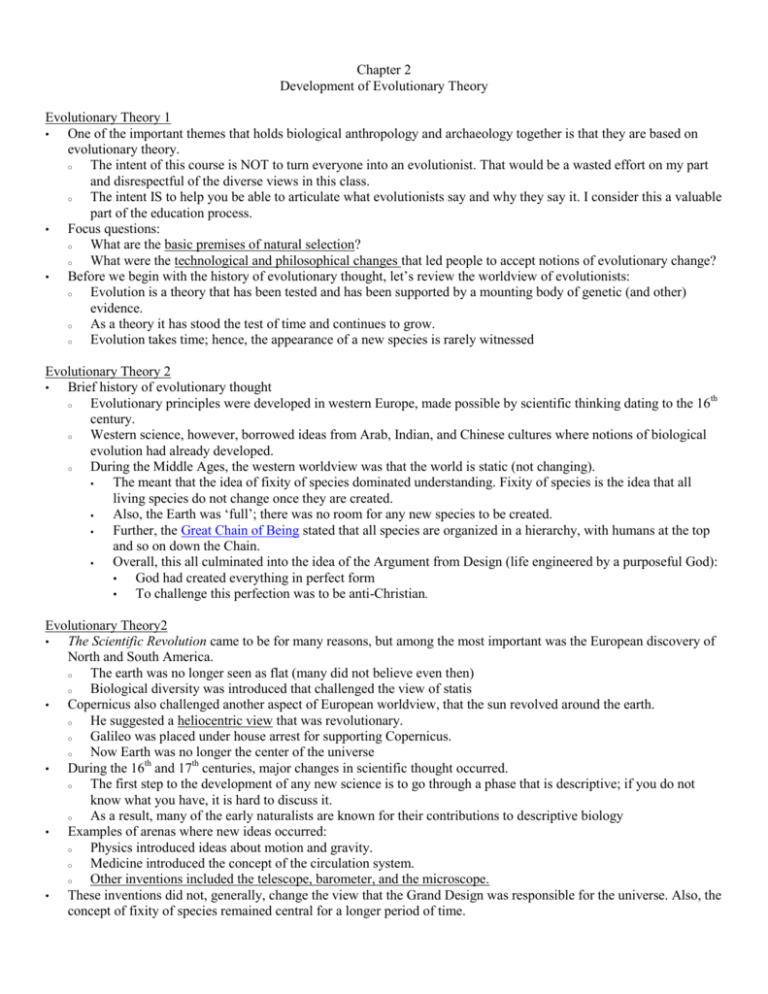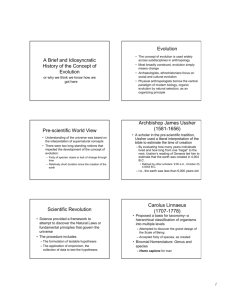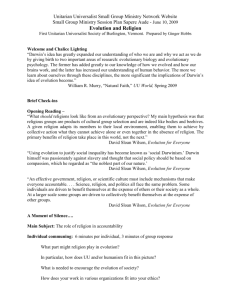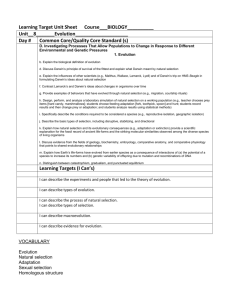Chapter 2 - Cynthia Clarke
advertisement

Chapter 2 Development of Evolutionary Theory Evolutionary Theory 1 • One of the important themes that holds biological anthropology and archaeology together is that they are based on evolutionary theory. o The intent of this course is NOT to turn everyone into an evolutionist. That would be a wasted effort on my part and disrespectful of the diverse views in this class. o The intent IS to help you be able to articulate what evolutionists say and why they say it. I consider this a valuable part of the education process. • Focus questions: o What are the basic premises of natural selection? o What were the technological and philosophical changes that led people to accept notions of evolutionary change? • Before we begin with the history of evolutionary thought, let’s review the worldview of evolutionists: o Evolution is a theory that has been tested and has been supported by a mounting body of genetic (and other) evidence. o As a theory it has stood the test of time and continues to grow. o Evolution takes time; hence, the appearance of a new species is rarely witnessed Evolutionary Theory 2 • Brief history of evolutionary thought o Evolutionary principles were developed in western Europe, made possible by scientific thinking dating to the 16th century. o Western science, however, borrowed ideas from Arab, Indian, and Chinese cultures where notions of biological evolution had already developed. o During the Middle Ages, the western worldview was that the world is static (not changing). The meant that the idea of fixity of species dominated understanding. Fixity of species is the idea that all living species do not change once they are created. Also, the Earth was ‘full’; there was no room for any new species to be created. Further, the Great Chain of Being stated that all species are organized in a hierarchy, with humans at the top and so on down the Chain. Overall, this all culminated into the idea of the Argument from Design (life engineered by a purposeful God): • God had created everything in perfect form • To challenge this perfection was to be anti-Christian. Evolutionary Theory2 • The Scientific Revolution came to be for many reasons, but among the most important was the European discovery of North and South America. o The earth was no longer seen as flat (many did not believe even then) o Biological diversity was introduced that challenged the view of statis • Copernicus also challenged another aspect of European worldview, that the sun revolved around the earth. o He suggested a heliocentric view that was revolutionary. o Galileo was placed under house arrest for supporting Copernicus. o Now Earth was no longer the center of the universe • During the 16th and 17th centuries, major changes in scientific thought occurred. o The first step to the development of any new science is to go through a phase that is descriptive; if you do not know what you have, it is hard to discuss it. o As a result, many of the early naturalists are known for their contributions to descriptive biology • Examples of arenas where new ideas occurred: o Physics introduced ideas about motion and gravity. o Medicine introduced the concept of the circulation system. o Other inventions included the telescope, barometer, and the microscope. • These inventions did not, generally, change the view that the Grand Design was responsible for the universe. Also, the concept of fixity of species remained central for a longer period of time. The Scientific Revolution 1 • One barrier to the acceptance of evolution was the concept of fixity of species: The notion that species, once created, can never change o Fixity of species is an idea diametrically opposed to theories of biological evolution. o To challenge the idea was to challenge the Argument from Design • The Scientific Revolution came to be for many reasons, but among the most important was the European discovery of North and South America. • Challenges to traditional beliefs wherein Aristotle had taught that the sun and planets existed in a series of concentric spheres that revolved around the sun. o Copernicus challenged the idea that the earth (geocentric) was the center of the universe o Galileo’s work supported the idea that the universe was a place of motion. The Scientific Revolution 2 • • • During the 16th and 17th centuries, major changes in scientific thought occurred. o Physics introduced ideas about motion and gravity. o Medicine introduced the concept of the circulation system. o Other inventions included the telescope, barometer, and the microscope. These inventions did not, generally, change the view that Argument by Design was responsible for the universe. Consequences of the challenges was a shifting paradigm o The earth was no longer seen as flat o Biological diversity was introduced and attempts to explain the diversity proliferated o Now the Sun (heliocentric) or Earth (geocentric) was no longer the center of the universe o Fixity of species remained central for a longer period of time then concepts derived from disciplines we now call physics, astronomy and chemistry. Precursors to the Theory of Evolution 1 • The first step to the development of any new science is to go through a phase that is descriptive; if you do not know what you have, it is hard to discuss it. o As a result, many of the early naturalists are known for their contributions to descriptive biology o The early researchers continued to view the world from a fixity of species perspective and were interested in describing the Argument by Design. • John Ray (1627-1705) o Introduced the concept of species as based on reproductive success He realized that groups of organisms could be differentiated based on the ability to reproduce with each other (or not). Today we call this idea the Biological Species Concept (BSC) • The BSC can be defined in terms of reproductive capability. • If organisms from two populations are capable of breeding naturally and can produce fertile offspring, they are classified in the same species. Example: the mule • The result of breeding a donkey with a horse is the infertile mule • Assumes two organisms either belong to same species or not (mutually exclusive), but this may not be always clear: • Example: gypsy moths: far away populations produce infertile offspring, closer together produce fertile offspring o Also recognized that species can share characteristics. He grouped them into what he called the same genus (plural is genera). Precursors to the Theory of Evolution 2 • Carolus Linnaeus (1707-1778) o A Swedish naturalist who developed a method of classifying plants and animals. 115_Chapter 2 Page 2 o o o In Systema naturae, first published in 1735, he standardized Ray’s use of genus and species terminology and established the system of binomial nomenclature. He standardized the genus and species into this binomial nomenclature He added to more levels of classification: class and order He also included humans in the classification system Homo sapiens (note that the genus is capitalized, the species is not; also in italics). Including humans was controversial as most thought of humans as separate from other living organisms. He did create a set of racial groups within the listing wherein he put Europeans at the apex and Africans at the base. He grouped humans into his classification system Homo sapiens is the scientific name for humans This was a controversial position at the time; it countered the idea that humans were special, made in the image of the Christian deity Precursors to the Theory of Evolution 3 • Georges-Louis Leclerc de Buffon (1707-1788) o He was an 18th century thinker who believed that living forms changed in response to the environment yet still rejected the idea that one species could give rise to another. He did not adhere to the concepts of perfection in nature nor in the concept that nature had a goal. He talked to the idea that the universe is changeable. He also stated that the external environment and living organisms are in a relationship that explains the changing nature of species. o His idea was that species changed gradually, influenced by the local environment o He influenced two important naturalists: Jean-Baptiste Lamarck and Georges Cuvier. • Erasmus Darwin (1731-1802) o Charles Darwin’s grandfather o Physician, poet, and leading member of an intellectual community in England In a poem, expressed the view that life had originated in the seas and all species descended from a common ancestor. Charles read his grandfather’s writings, but how much he was influenced by them is unknown. Precursors to the Theory of Evolution 4 • Jean-Baptiste Lamarck (1744-1829) o First scientist who codified his beliefs into a system that attempted to explain evolution. o Thought physical alteration occurred because of bodily needs (called besoin) o Basic idea was the inheritance of acquired characteristics (use-disuse theory) where a trait acquired during lifetime is based down to offspring. o An example is the giraffe: having stripped the leaves from the lower branches of a tree, the animal tries to reach leaves on upper branches. The neck becomes slightly longer. The longer neck is passed on to offspring. Precursors to the Theory of Evolution 5 • Georges Cuvier (1769-1832) o Was adamant about the fixity of species, Lamarck's chief opponent. o Introduced the idea of catastrophism to explain the fossil record. Multiple disasters resulted in the repopulation of regions by newly created organisms • Thomas Malthus (1766-1834) o Author of an essay, An essay on the principle of population, that inspired both Charles Darwin and Alfred Wallace in their separate discoveries of natural selection. Was arguing for limits of human population growth, not concerned with how species change. Malthusian curve 115_Chapter 2 Page 3 The limits for populations to increase is controlled by availability of resources. Concerned with relationship of human population growth to food supplies. The idea of population-resources being linked was extended to all organisms by Darwin and Wallace. Malthus is considered the father of demography. He influenced a group who came to be called social Darwinism Social Darwinists were concerned with the overpopulation of the lower classes. o o Precursors to the Theory of Evolution 6 • Charles Lyell (1797-1875) o A lawyer, geologist, and, for Charles Darwin’s friend and mentor. o Before meeting Darwin in 1836, Lyell had earned acceptance in Europe’s most prestigious scientific circles, thanks to his praised Principles of geology, published during the years 1830–1833. o Proponent of theory of uniformitarianism The theory that the earth’s features are the result of long-term natural processes (i.e. wind, water erosion, local flooding, frost, decomposition, volcanoes, earthquakes, and glacial movements) that continue to operate in the present as they did in the past. Proposed by James Hutton, elaborated on by Lyell, this theory opposed catastrophism and contributed strongly to the concept of immense geological time (Earth is old) • Mary Anning (1799-1847) o She discovered the first fossilized Pleiosaurus (ocean-dwelling reptile) while exploring near her home in Dorset, England. Became known as one of the world’s leading “fossilists.” When her father died, Anning began collecting and selling marine fossils to support her family. o Because of her gender, she was not allowed into the inner circles of British naturalists. Even so, her fossils were sought by many of these same men, including Lyell. Darwin and Wallace 1 • Many of the early transmutationists were strongly anti-Christian; this set the tone of the discussion for many by the time that natural selection was suggested o The idea of transmutation is the shift of one type of species into another over time. o Both Darwin and Wallace introduced transmutation; its time had come: Charles Darwin formulated theory of natural selection. Darwin talked to the idea of struggle for existence. • The idea that in each generation more offspring are born than survive to adulthood, coupled with the notions of competition for resources and biological diversity led to the theory of evolution. • He wrote,“ It at once struck me that under these circumstances favourable variations would tend to be preserved, and unfavourable ones to be destroyed.” • FYI: Herbert Spencer (not a biologist) coined the phrase survival of the fittest. Alfred Russel Wallace uncovered the key to the evolutionary process. • Charles Darwin (1809-1882) o Ideas were formed while serving as a naturalist on the 5-year voyage of the HMS Beagle. o Darwin saw the importance of biological variation within a species. Most famous example is Darwin’s finches. o Recognized that sexual reproduction increased variation, but did not yet know why. Darwin and Wallace 2 • Alfred Russel Wallace (1823-1913) o Suggested species descended from other species (speciation) and new species were influenced by environmental factors. o Wallace published a paper on speciation and soon sent another paper to Darwin in 1858. o As a result, he presented joint paper, coauthored with Darwin, on evolution and natural selection to the Linnean Society of London. Little notice was taken. o Next, in 1859, Darwin published his On the origin of species, and an uproar began that continues today. 115_Chapter 2 Page 4 • • The origin of species, according to Darwin and Wallace, is explained: Species are mutable (not fixed) and they evolve from each other. Darwin and Wallace view of evolution: o Environment favors individuals with long necks o Those individuals more likely than others to have offspring Natural Selection: The “Key” to Evolution • • • Once Darwin understood how selection occurs in nature, he outlined the processes. The basic processes of natural selection: 1. All species produce offspring at a faster rate than food supplies can increase 2. Except for identical twins, no two individuals are exactly alike. 3. In each generation, more individuals are produced than can survive. 4. Individuals that possess certain traits have an advantage over those that do not. 5. The environment determines whether a trait is beneficial. 6. Traits are inherited and passed on to the next generation. 7. Over time, successful variations accumulate in a population, and a new species may appear. 8. Geographical isolation may lead to the formation of a new species. Geographical isolation (distance, natural barriers such as oceans) contributes to the formation of new species as individuals begin to adapt to different environments. Selective pressures (differential ecological circumstances) cause distinct species to develop. See, for example, the 13 species of Galápagos finches presumably all descended from a common South American ancestor Natural Selection in Action • Gradualism was Darwin’s view on how species occur. o Over long periods of geological time, successful variations accumulate in a population o Later generations may be distinct from ancestral ones, or a new species can appear. o Key concept: Natural selection operates on individuals, but it’s the population that evolves • Famous examples of natural selection: o Again, Darwin finches on the Galapagos o The example of dog breeding o Industrial melanism as evidenced by the peppered moths o Antibiotic resistance today • Evolutionary change through natural selection 1. A trait must be inherited in order to have importance in natural selection. 2. Natural selection cannot occur without variation in inherited characteristics. 3. Fitness is a relative measure that will change as the environment changes. Fitness • Fitness, as a term in biology pertains, to natural selection, a measure of relative reproductive success of individuals. o The terms genetic fitness, reproductive fitness, and differential reproductive success are also used. o Fitness can be measured by an individual’s genetic contribution to the next generation compared to that of other individuals. The terms fecundity and fertility are important here. Fecundity refers to the ability to conceive and produce healthy offspring. • We should ask if a person is fecund, not fertile. • The book uses the term fertility and so in not correct. Fertility refers to the number of live offspring produced by an individual An animal that gives birth to more young passes its genes on a faster rate than one that bears few offspring. 115_Chapter 2 Page 5 o Fitness is measured on a scale from 0 (zero) to 1 (one). The record for the most live births by a single woman is 69 so she had a value of 1. Of these, 67 lived past infancy. Discovery of DNA and GeneticsDiscovery of DNA and Genetics • Darwin understood natural selection, but not the mechanisms of evolutionary change o No-one in the 19th century understood the actual source of variation o 19th century scholars believed inheritance was a blending process in which parental characteristics were mixed to produce intermediate expressions in offspring. o This is the source of concepts like ‘bad blood’ and ‘blue blood’ • The modern understandings of inheritance o Only with the discovery of Mendel’s work did the mechanism become clear In 1953, the structure of deoxyribonucleic acid (DNA) was discovered. This was followed by even more advances in the field of genetics, including the sequencing of the human genome. With the discovery of the structure of DNA came the understanding of the entire genetic makeup of an individual (genome) or species. o Human and chimpanzee genomes were sequenced in 2003 and 2005, respectively. Opposition to Evolution • Almost half of all Americans believe that evolution does not occur. Some reasons: o Evolution is complex and is not easily explained. o Relation between science and religion has never been easy. o Also, most cultures do not emphasize the biological continuity When expressions of a phenomenon continuously grade into one another so that there are no discrete categories, they exist on a continuum. Color is one such phenomenon, and life-forms are another. The biological continuum recognizes that organisms are related through common ancestry and traits present in one species are also seen to varying degrees in others. • Five (5) myths about evolution o Myth 1: Evolutionary theory denies the existence of God. o Response 1: In fact, science does not ask these questions, so the debate does not really center here. o Myth 2: Evolutionary theory claims life is one huge, incredible accident. o Response 2: Just the opposite. There are very specific mechanisms of evolution that we will discuss in later chapters. Opposition to Evolution 2 • Five (5) myths about evolution (continued) o Myth 3: A scientific debate exists concerning the existence of evolution Response 3: According to Newsweek (1987) “"By one count there are some 700 scientists with respectable academic credentials (out of a total of 480,000 U.S. earth and life scientists) who give credence to creationscience...“ (Source: http://www.religioustolerance.org/ev_publi.htm#earth ) o Evolutionary theory preaches progress. Response 4: “Evolution is not progress. Populations simply adapt to their current surroundings” (Colby, 1996) o Evolutionary theory says humans are ‘just animals’. Response 5: Of course humans are animals; it is the just part that is in error. All animals have unique evolutionary histories, and among those for humans is the use of culture to adapt. No other species is as good at it as we are. But, all species are unique and this is important to note. • Great website to read more: www.bio.ilstu.edu/armstrong/misconceptions.doc Kinds of Evidence for Evolution • Fossil record o The fossil record gives evidence for species loss, introduction, and change. 115_Chapter 2 Page 6 Gaps in the fossil record are due to a lack of data collection. We will see many examples of fossil discoveries this quarter where former gaps are being filled. Chemical and anatomical similarities: All living organisms share either DNA or RNA The structural similarities of anatomy among closely related organisms o Homologous organs are those that come from shared evolutionary history (forelimbs of humans, whales, dogs, and birds) o They differ from analogous organs which are those that result from convergent evolution (wings of insects and of bats) o Vestigial organs argue against a Grand Design (appendix for instance) Geographic distribution o Absent of many species in isolated places o In these same isolated places other species, seen nowhere else, exist. Genetic changes in living organisms over many generations discussed earlier o • • • • Source: O’Neil, D. (2010). Evidence of evolution. Retrieved from http://anthro.palomar.edu/evolve/evolve_3.htm Religion and Science • One of the greatest controversies regarding education in the United States and other parts of the world is the teaching of evolution. o Stance of most scientists: Religion and science concern different aspects of the human experience, and they are not inherently mutually exclusive categories. Belief in God does not exclude the possibility of biological evolution; acknowledgement of evolutionary processes doesn’t preclude the existence of God. o Stance of religious groups: Evolutionary theories are not rejected by all religions or by most forms of Christianity. Some groups do struggle with evolutionary ideas and include Christian fundamentalists and those who support scientific creationism or intelligent design. • Those in this later group argue that creation science and intelligent design (ID) is as much a scientific endeavor as is evolution, and suggest scientific evidence to support creationist views. • ID is not science, however • Creationists argue their view is absolute and fallible, which is counter to science which seeks testable hypotheses. 115_Chapter 2 Page 7








